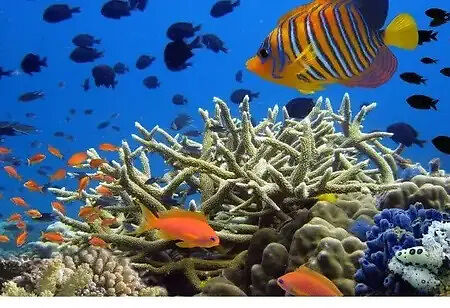
Blue Food Revolution: Steering the Waves of Modern Aquaculture


The world farms more seafood with every passing year. The Asia-Pacific area is impressively the world's largest fish producer, accounting for more than half of global production, creating a sizable sector constantly looking for innovative technology to boost productivity. In fact, Indonesia produces almost six million metric tons of fish yearly, making it one of Singapore's closest neighbors in Southeast Asia to consistently reach some of the highest levels in Asia outside of China. Researchers have planned to continue investing in cutting-edge aquaculture technologies to maintain production. When carried out sustainably, aquaculture, which ranges from seaweed farming to fish farming, can feed millions of people, help national economies, and safeguard coastal habitats.
Singapore, one of the most water-stressed nations in the world, has started a number of projects to reduce its dependency on imports for a reliable and reasonable water supply. The best possible utilization of the nation's water resources is a key component of many of these projects. Due to this special circumstance, Singapore has developed into a hub for water and used water technology globally, propelling the country to become known as a Water Hub in Southeast Asia.
By founding Pacific Island Tuna, a new vertically integrated, sustainable end-to-end tuna supply chain company, TNC is also making a significant step towards reforming the current tuna supply chain. This effort aims to decrease the bycatch of young tunas and endangered species while also developing a reliable source of financing for local conservation projects. Pacific Island Tuna, a corporation located in the Republic of the Marshall Islands, will ensure that Pacific Island nations directly own their tuna catch from the dock to merchants and that a portion of net income goes to neighborhood conservation initiatives.
Swimming against the Current
In addition to a sea of vast and successful fish farms, Southeast Asia is home to many tiny farms. One major challenge they face is a lack of funds for infrastructure and technological investments that may facilitate the transition from traditional methods to intensive and sustainable aquaculture. Smallholder farmers today run the risk of getting infections and having the quality of their farm's produce damaged when they raise fish on a large scale. Rural areas can have access to far more land and water than urban areas, but these areas usually lack infrastructure like roads and electricity.
High-intensity aquaculture output can be sustained and water quality maintained with the help of the proper infrastructure. Another problem could be related to this restriction on access. The complex structure of the seafood value chains, which further restricts the farmers' ability to afford capital-intensive technology, is said to prevent smallholder farmers from receiving sufficient benefits to support capital, according to experts who spoke at an IPI roundtable on sustainable aquaculture water management last year. Other manufacturing expenses, such as those for transportation, feed, and labor, are also said to have increased, further complicating issues. As a result, consumer prices continue to rise, and manufacturing inefficiencies continue to worsen, potentially leading to significant food waste.
Before we can assist the farmers, we must adjust at each stage. Lim also mentioned that enabling farmers to make technology investments to overcome their difficulties would be a success factor.
The Role of Tech
With accessible, cutting-edge technology that can uplift smallholder farmers and expand Southeast Asia's aquaculture industry, some of these issues can be avoided. Aspiring IT companies in Southeast Asia have the chance to create ground-breaking solutions, notably in the areas of water management and water monitoring. For instance, using biofiltration for local fish rearing in closed-circuit production and controlled environments, such as in a recirculating aquaculture system (RAS), may enable more sustainable land-based aquaculture with better disease control, higher levels of production, and a smaller environmental impact. The aquaculture roundtable speakers also emphasized the necessity for prospective aquaculture entrepreneurs and technology providers to collaborate with biological specialists in order to create technology that can meet the specific requirements of each species. In reality, surveillance and monitoring technology has already made it possible for farmers to monitor behaviors like swimming patterns and skin lesions, which has increased the possibility of early illness identification. However, the panelists advise consulting a biological expert in order to fully reap the rewards of the technology.
A lot of this technology has been developed for fresh water and cold water. According to Prof Jose Domingos from James Cook University Singapore, “One tendency I see when newcomers want to adapt the service to marine warm water situations, they try to replicate what is in Europe without considering production or biological differences. More importantly, tech players should be not only able to adapt to geographical concerns but also socioeconomic challenges like limited profit margins and capabilities of local farmers. Ultimately, they are confident that the costs of technological innovations in aquaculture will decrease over time, and maintenance will be made more convenient as demand for technology rises.
The roundtable discussion made it very evident that other parties besides technology suppliers are also responsible for bolstering the aquaculture sector. In order to take advantage of the potential given by the increase in demand for sustainably farmed seafood to feed the region, the entire ecosystem must work together. The aquaculture industry in Singapore can concentrate on developing distinctive selling factors, including supply reliability and offers of value-added products like prepared, ready-to-eat, or ready-to-cook seafood. Although the government encourages the industry's expansion, it is still difficult to locate trained farm laborers. By providing young Singaporeans with the necessary training, local higher education institutions can close this knowledge gap. Fortunately, young people in the nation have already expressed an interest in exploring this area and using automation to maximize its potential.
Singapore may be able to supply food for the local population in a sustainable manner through group efforts, and it may also help the aquaculture sector in Southeast Asia expand.

